Unfortunately, the email from Robin had been written from inside the inn. The tickets were already paid for... in cash, and just as expensive as we feared. We spent the evening calling the travel agent to try to give her our passport numbers and then spent the next two days chasing them around ("They'll be delivered tomorrow at 11, no wait, 5, no wait, you weren't at the hotel so we took them to Ollantaytambo, they'll be at a mini-market there waiting for you.") In the end we got the tickets the night before the train ride. So we won't be able to tell you the full proof layout for how to get to Aguas Calientes without paying $125 return tickets on the train. But the advice that we can give is this: go to Pisac or any of the surrounding towns and ask around. Most of the people who live there will offer suggestions. The bill will probably go down to 10 soles (although everything costs more than people say it will).
Despite the stressful introduction, we all had a wonderful evening together. We paid way too much for a hotel in Pisac (and yet, still much less than any hotel in the US would have cost - $80 USD for all four of us), reserved by Courtney's mom, that turned out to be the most comfortable and amazing hotel experience Chris and Courtney had ever had. Tea service with delicious brownies, breakfast with eggs and fresh papaya/orange juice, soft beds with QUALITY linens and down comforters (as opposed to thick heavy wool blankets) and a beautiful courtyard. We showered, washed clothes and ate dinner together. Laurie even footed the bill for the hotel.
Pisac is famous for the Incan Ruins on the hillside above. One can take a taxi there or walk up the mountainside for 5km. Chris and Laurie took the taxi. Courtney and Robin opted for the hike. The scenery was beautiful and the ruins were impressive. High above the river valley, complete with classic Incan terrace work. The site wasn't very populated with tourists so we had a nice quiet time. Chris, Robin and Courtney summited the mountain and we were all very proud. The view was fantastic.
The name Pisac originates from the word pisaca or partridge and is laid out to resemble a bird from an aerial view. It was once a great Inca city including a temple and a military zone. The different zones were identified by the levels of stone work - rougher stones used in every day home building and more intricate interlocking stonework for the military and upper-class zones. The Temple was built with perfectly sized and polished interlocking stones. They had a connection to the land that is somewhat zen - utilizing existing rock formations and the shape of the land to create their city. The Incas often incorporated these formations as part of the structure of the buildings they were erecting - as a wall or the foundation etc. In the Temple zone the formations were left natural and seem to have spiritual significance. Another example: there were 3 tunnels in the pathways through the city that were made from natural clefts in the mountainside. The Incas were a tiny people so it was difficult even for Chris to crawl through them.
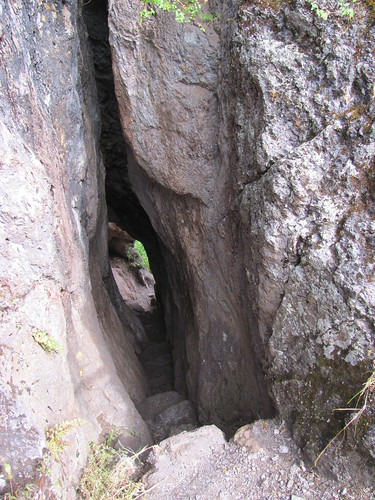 One of the tunnels that we had to squeeze through in the Pisaq ruins.
One of the tunnels that we had to squeeze through in the Pisaq ruins. Laurie posing with a few amazing rocks: perfectly polished and formed (both Laurie and the rocks).
Laurie posing with a few amazing rocks: perfectly polished and formed (both Laurie and the rocks).These stones are not just sitting one on top of the other. They are the original LEGO. They are formed to fit one inside the other. No two rocks are the same. Amazing.
Their burial technique was extremely interesting. Set in the walls of the opposing mountains were thousands of burial caves. The caves were hollowed out by the Incas and important figures were mummified and placed in the caves looking outward toward the city. Burying them this way allowed the dead to watch over the city for eternity. Eternity wasn't that long however. Since there is no evidence of pre-Inca life on this site, it's assumed that the site is only 600 years old. About a century after it was built, the Spaniards came and destroyed the site along with everything else in their path.
Because we are slow, as a general rule, we got to the entrance of the ruins after the sun had set and there was little chance of us finding a taxi to take us home. We walked about half way to Pisac (5km) before finding a couple of "taxi drivers" (In a mini-market hanging out with their friends. Most likely they were just guys with a car who thought, "Hey, we're going to Pisac anyway, we might as well make 15 soles out of the deal." But Courtney talked them down to under 10 soles and away we went.) We bought fruit and pastries and ate dinner in the hotel. We had moved to the hotel around the corner for less than a third of the price of Pisac Inn. It was a really nice place as well and came with a bonus: a fruiting fig tree right in our courtyard! Yum.
The plans for the following day were elaborate and therefore didn't work out quite as we had hoped but we all had a fun time anyway. We had bought a ticket that let us go to any of four sites in the valley. Since we had the option to go to two of the ruins that were on the way to Ollantaytambo, we worked out a place and time to meet in Urubamba, the big city near the ruins. Chris and Courtney biked while Robin and Laurie "took the bus." Evidently the bus never came. They were offered a taxi for S./30 and a nice local lady helped them talk the driver down to S./3 per person. Due to the delay, they were an hour and a half late meeting us. Instead of seeing the ruins we ate lunch in Urubamba - paying Argentina prices for pizza. But, unlike in Argentina, the pizza was delicious.
Then Chris and Courtney continued on to Ollantaytambo by bike and we convened once again. We got a hostel with a scorpion for a roommate at a great price and then went to the ruins that loomed above the city. The mountain sides are a popular place to visit Inca ruins. The Incas had an aversion to the valley below (flooding, perhaps?) and built all of their cities of the sacred valley high up. We arrived a little late but still had enough time to see the whole site, although we were the last people to leave and the guard had to usher us out.
Ollantaytambo was the royal estate of Emperor Pachacuti, the conqueror of the region. Pachacuti died before the conquistadores arrived but the estate was left to his family clan. Manco Inca, leader of the native resistance against the conquistadores was using Ollantaytambo as a temporary capital. In 1536 he successfully fended off the Spanish invaders who termed the city "the fortress" even though this was not it's original function. The name stuck. It is known as the fortress even by the locals. Rightly nicknamed too. It would be difficult to defeat an army inside those walls. Some of the stones we saw in the ruins were the size of SUVs. Plus, having built their cities in the sides of the mountains, the Incas definitely had the high ground.
 Courtney getting cozy with some of the enormous and well formed rocks that made up a wall in the ruins at Ollantaytambo.
Courtney getting cozy with some of the enormous and well formed rocks that made up a wall in the ruins at Ollantaytambo.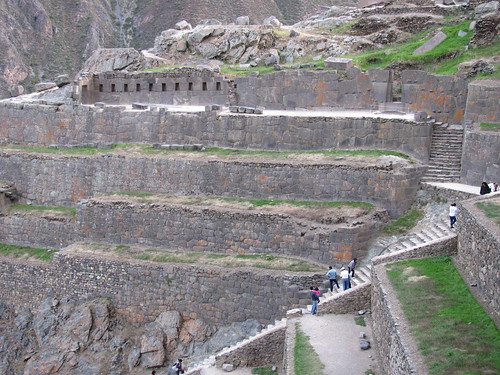 The Fortress. Ollantaytambo, Perú.
The Fortress. Ollantaytambo, Perú.Early the next morning we got on a train to Aguas Calientes, the town outside of Machu Picchu. The town is surprisingly difficult to navigate and it took us an hour just to find our hostel - once again reserved for us by Courtney's mom. Laurie had come all this way to fulfill the life long dream of seeing Machu Picchu so he bought tickets for 2 days. The rest of us bought tickets for 1 day and decided to see how we felt after seeing it the first time. There was a perk to going a second day. Wayna Picchu, the mountain one sees in the background of every picture of Machu Picchu, is hikeable, but only to 400 people per day. If we went a second day, we could get up at 4 am to hike up to Machu Picchu from Aguas Calientes, then run from one side of the ruins to the other in order to get in line before the other several hundred people, all doing the same thing, and maybe get to hike up to the top.
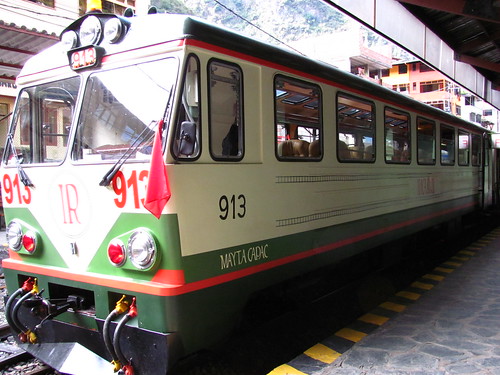 Our steed. The train that brought us to Aguas Calientes.
Our steed. The train that brought us to Aguas Calientes.A much nicer experience than the ride back to Ollantaytambo. Leather seats, fancy snacks and chocolates...
 Fun on the train.
Fun on the train. On this day, however, we arrived at the ruins by bus. They were not very crowded, so Chris, Courtney, and Robin made their way to the entrance to Wayna Picchu to see if they would be let in. At 12:45pm we were numbers 363, 364, and 365 to enter the hike. Que Suerte! From a distance, Wayna Picchu looks like a steeply angled cone. To ascend, one climbs many stairs carved into the rock, sometimes with the aid of modern railings and ropes. At the top are more very small steep stairs that circle the peak and give access to the ruins there.
 Hey look! It's us (Robin, Courtney, Chris) at the top of Wayna Picchu!
Hey look! It's us (Robin, Courtney, Chris) at the top of Wayna Picchu!Altitude: 2634 msnm. UTM: 766050E 8544183N
 Chris standing perilously at the top of one of the steep stairwells leading to the summit of Wayna Picchu.
Chris standing perilously at the top of one of the steep stairwells leading to the summit of Wayna Picchu. One more excellent example of the use of natural rock formations as a foundation in the building of the Inca cities.
One more excellent example of the use of natural rock formations as a foundation in the building of the Inca cities.The view is not bad. Machu Picchu is in such good condition because it is very remote, and was undiscovered until 1912. High above the river valley, there are no obnoxious modern constructions to interfere with the zen feeling (aside from the entrance where one finds a cafeteria, gift shop and hotel - rooms starting at $825 per night and going up to $1400 (champagne on arrival, massage and full board) - but these are not visible from the ruins). The clouds that hang over the surrounding mountains create a serene, safe atmosphere. Walking through the mostly pristine ruins, a feeling of inner peace is tempered by a recurring ambition to take the perfect photograph.
In the end Machu Picchu was not as amazing as it was built up to be. It is certainly the most impressive of the three ruins that we saw and very well kept. But is it worth the $125 train fair, $15 bus ride and $45 entrance fee? For us this is a stupid question because the money is spent and the ruins were seen. No un-doing that. The best part of Machu Picchu for us were the hikes we did - to Wayna Picchu and to the Inca Bridge - quiet, really beautiful landscape and folliage. The views were amazing. The ruins - well we had seen a lot of ruins at that point. Very impressive, but just ruins all the same. Machu Picchu was a city of rich people on the top of the mountain. This was their resting place - their spa. The people were no more or less exotic than us, just people trying to eat, breed, sleep, build, survive - and obviously doing a good job if they managed to reach the level of spa treatment in their civilization.
As is our M.O. we were the last people to leave the ruins. We decided at the last minute to go see the Inca Bridge. The Incas had built stones up the side of the mountain to create a pathway along a cliff wall. Amazing architecture. We were running back from the hike and emerged from the starting point to find a completely empty Machu Picchu - a breathtaking sight.
 The Inca Bridge. The hand built wall goes all the way across the photo. Built up from the cliff wall up to the ridge that the Incas walked on back in the day. Now it's blocked off as "unsafe." Probably not true since most other Inca structures outlasted all of the Spanish buildings through a few different earthquakes.
The Inca Bridge. The hand built wall goes all the way across the photo. Built up from the cliff wall up to the ridge that the Incas walked on back in the day. Now it's blocked off as "unsafe." Probably not true since most other Inca structures outlasted all of the Spanish buildings through a few different earthquakes.We had planned to hike down to Aguas Calientes instead of taking the bus, but because we were so late, the sun had begun to set so we paid for the bus. Before resting we made a trip to the most expensive mercado in all of South America and prepared dinner in the hotel.
Laurie spent the following day at the ruins in the rain while Courtney, Chris and Robin relaxed - we had summited 3 mountains in 3 days and were very sore (It turns out that biking is very different from hiking). Robin, however, was fine. She walks to and from work every day and has great hiking legs. We took the train back to Ollantaytambo in the evening and stayed at the same hotel - no scorpion this time - and were reunited with our bicycles. And in the morning we wandered the streets of the city. Ollantaytambo is unique because the Spaniards did not destroy it. The modern city is built on the foundations of the Incan ruins. It was beautiful. The streets were narrow straight lines with water canals running along the sides, just like in the ruins above the city.
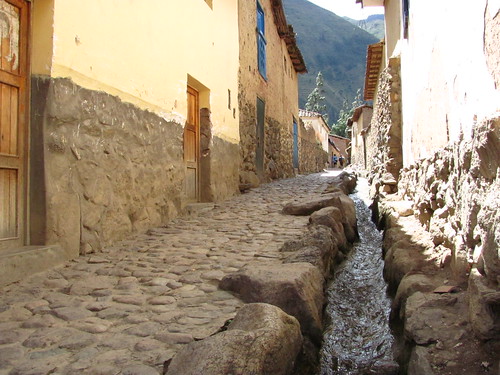 The street-side canals in Ollantaytambo, Perú. You can see from this picture
The street-side canals in Ollantaytambo, Perú. You can see from this picturehow the modern structures are built on top of the stone Incan foundations.
In the afternoon we took a bus to Cusco and had a fun night without water due to the street construction outside. After they lied to us over and over about when the water would be turned back on, we informed them that we were going to pay half price (S./40 - an above average price for Perú but a good price for Cusco) and they did not argue with us. After dark we walked around Cusco to see the many many churches and plazas. The city is most beautiful at night. The buildings are lit up and magical. Plus, at night one can't see the haze that hovers over the city.
The next day we took a tour of the Temple of the Sun or Qorikancha which, after the Spaniards moved in was turned into a Catholic church. We got a tour guide and he gave us an hour tour (for a very small space. It was chalk full of fun facts). The site had been hit by 2 enormous earthquakes since the Spaniards had built their church. The Inca structure had been undamaged while the Spanish Church had been destroyed.
The following 40 hours were a blur. We bussed from Cusco to Lima, then Lima to Trujillo, with only a brief 6 hour layover in Lima which was filled with the task of getting ourselves and all our stuff from one bus station to the next.
Trujillo is a large cloudy city on the north coast of Perú. The second largest city in the country. We spent our final 4 days there. In Cusco Provence we spent too much time traveling around so instead of driving up and down the coast we picked a spot on the map and settled in. While our primary goal was to eat lots of Ceviche (spelled Cebiche in Perú) and relax by the beach, there are more, easily accessed ruins near the city.
For our first outing we went to Huanchaco, a beach town nearby. We rolled around in the sand and swam a bit. The water was pretty cold - we were a month into Fall at this point. But the sun was warm and Robin and Courtney walked around looking at crafts and drying off. All together we ate a huge feast of cebiche (fish marinated in lemon juice, served with peppers and onions. Yum), chicharrones (deep fried anything, but in our case, seafood) and Pisco Sours (the national drink consisting of pisco, sour and whipped egg whites). Very touristy, also DELICIOUS.
We made our way back: Courtney and Chris by bike. Robin and Laurie by bus. Robin, Courtney and Chris wandered the streets looking for more cebiche for dinner but learned that it's a lunch food, so we were out of luck. We had a long day ahead so we got some take out and went back to the hotel.
The day we had planned was a trip to the Ruinas de Chan Chan. Chan means Sun. The double Chan Chan is supposed to mean Great Sun or Resplendent Sun or something of that sort. The sun obviously played and important roll in for the Chimú (the people who inhabited Chan Chan). Perhaps it was easier for them to accept Inti (the Inca God, also the sun) as their supreme god once they were conquered (along with the rest of Perú, Bolivia, Ecuador, Northern Argentina and many other parts of South America).
The ruins are actually of an entire city. They make up the largest adobe structure in all of Latin America (the 2nd largest in the world). The Architecture is what makes Chan Chan so interesting. The detail work in the adobe is amazing. The diamond-lattice patterns in the architecture represent fishing nets, giving us an idea of how important fishing and the sea was to the Chimú people of Chan Chan. Designs of fish swimming in one direction show the normal direction of the Humboldt Current. A very short section at one end of the fish lined corridor shows them swimming in the other direction. This represents the short time when the Humboldt Current runs in the other direction: El Niño. Obviously, the recent floods in the Sacred Valley are on a long list of important events caused by El Niño.
Water also played an important roll for the Chimú. This is evident in their intricate water system. The portion of the ruins that had been restored (the portion we were shown) even had a small reservoir which is all that is left of the aqueduct system that the Chimú had built. When the Incas decided to conquer the Chimú they simply destroyed the aqueducts. Today, due to floods and need for a better water system, the people of Trujillo are considering restoring the highly advanced water system of the Chimú.
So after a fun day exploring the ruins we went on a search for food and found that everything was closed due to a mysterious festival that we never did understand completely. Finally we ran into a couple of guys who told us about a mercado right in the center of town that would still be open. We rushed over to it to pick out some treats for dinner and discovered that it was the fanciest mercado we'd ever seen. All sorts of nice cheese and olives. Chocolate and fancy nuts to choose from. A juice bar that also sold flan. We sat at the juice bar for quite some time, waiting for Chris to return from the wine store and had cup after cup of delicious papaya, apple, orange juice.
Chris had been chatting with the two men who directed us to the mercado and made friends. They wanted some help with their English so he met them in the plaza later. It turned out that they just wanted to hang out, write a sentence or two in English and then drink beer. Oops, they only had a S./ 100 note so Chris bought the beer. One of the guys made sure that Chris would pass on the message that Robin was cute and could be his American girlfriend.
After dinner we wandered around Trujillo at night, enjoying the lights and pretty architecture. Not quite noble but colorful and slightly European, just the same. Beautiful iron balconies, courtyards, trees... The Plaza is a pretty sight at night too. It's backed by a yellow church. Not remarkable compared to many churches of Perú but it complements the rest of the town in its simplistic style. In truth, it was very beautiful.
Early in the morning we rose to visit another site: Huacas del Sol y de la Luna: The Pyramids of the Sun and Moon. This was also an interesting place. The Moche people were living in the valley before the Chimú and are an early version of the same civilization. The Moche are known for their pottery and their love of human sacrifice. The Tumi, a national symbol and a recent addition to the S./ 1 coin, is actually the traditional sacrificial knife that was used by the Moche people during their religious ceremonies.
Their city was also made of adobe but most of it is still being restored. On either side of the residential area is a pyramid. We were fortunate enough to be able to walk around inside the Huaca de la Luna. It was beautifully built around the contours of the land. There is a huge stone on the top level that is probably something of a support beam throughout all the levels. This stone is the very stone used in sacrificial ceremonies. The pyramid does not come to a point. With each empire a new level is built and the lower level is filled and covered. The outside of the pyramid shows a different colorful mural for each level: 8 in all (Oddly, the lowest level is the smallest. As each empire grows, the levels become wider. The pyramid is upside down on the inside BUT each new empire builds the walls out to create what looks like a normal pyramid from the outside. Hard to explain... but because of this crazy upside down/right side up pyramid nonsense, one can see levels and levels of older murals underneath the outer most layer. Very complex. Very interesting.)
So that was it. On a recommendation from a local we went straight to a cebiche restaurant and ate some delicious food. On our way back to the hotel we stopped at the mercado to get a few things and drink some more juice and flan. The ladies who worked there were delighted to see us again. And then we readied ourselves for the bus ride to Lima.
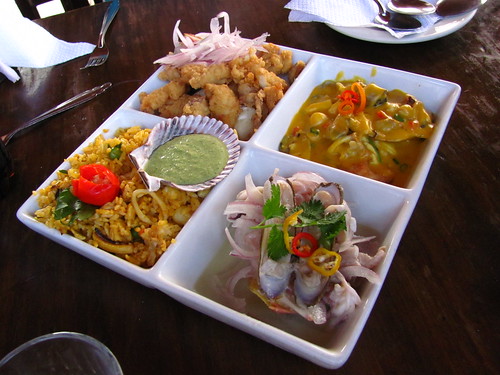 Our delightful last lunch in Trujillo. Cebiche in the bottom right corner.
Our delightful last lunch in Trujillo. Cebiche in the bottom right corner.We had a few hours to kill after we arrived in Lima. We filled our time well. We stayed mostly near the main plaza and never did get to see the super touristy part of town: Miraflores. We did get to see the river and ran some errands (buying big bags to consolidate our panniers). Looked at crafts, drank coffee, had a final cebiche meal (during happy hour). We had gotten a donation from Jeff Walls (a friend from Chris's School, University of Michigan in Ann Arbor) to go out with a bang: a final meal in Peru. We were instructed to drink too much. We didn't. But it was fun all the same. We ate good food and had some more Pisco Sours and talked about our favorite things. We walked around and saw some sights too. Mostly big fancy buildings. Very grand. We watched the changing of the guards on the Plaza too. A lovely marching band performance for the most part.
 We can still get excited about Inca Kola even after an all night bus ride.
We can still get excited about Inca Kola even after an all night bus ride.Also about directing traffic.
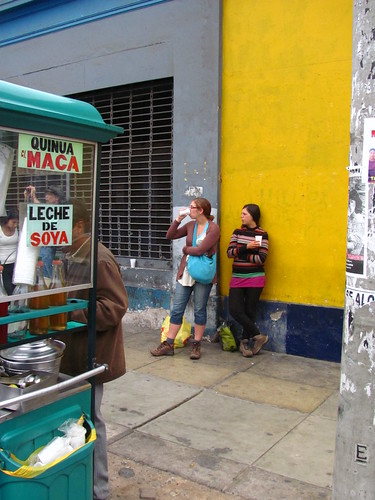 This stand was one of many stationed in the streets on our walk into Down Town Lima.
This stand was one of many stationed in the streets on our walk into Down Town Lima.Quinoa - Maca Drinks helped revive us after our long bus ride.
The final days of travel with Laurie and Robin had been wonderful, if not a bit rushed. We all felt the stress of too many hours of buses, hauling bikes around but not riding them, moving place too often (which is not as satisfying on a bus as it is on bikes). But we also saw many many beautiful things and had a great time. So knowing that, we all headed to the airport together. Laurie and Robin's flight was at 11:30pm on May 5th while ours was at 6:25 in the morning. So we piled in a taxi with the bikes strapped to the top. Only after we had been driving for a while did the taxi driver say, "Oh, it's illegal to drive with anything on top of the car in Lima. And they probably won't let me into the airport like this..." but we had no problems. Robin and Laurie got all set to take off and we said goodbye. We could hear their flight being announced over the loud speaker. Good bye Robin and Laurie!
Chris and Courtney spent the entire night in the airport. We had packed some food and ate at the food court then went over to the all night desert restaurant and took turns involuntarily falling asleep. Then we ordered ice cream at 3:30am: Chocolate, Lúcuma, Mocha. At 4:00am we hauled our bikes down to the lower level and got in line to check in.
Two days prior we had called ahead to ask what the bike policy was. Both the internet and the woman at the other end of the phone assured us that we only need to take the peddles off, and turn the handle bars to the side. Wrong. Or at least American Airlines at the Lima Airport would have nothing to do with it. After talking to several different people (time ticking) we finally convinced them that there was no way we were going to get back to Lima, find a box (let alone 2) for our bikes, pack them, get back to the airport and fly out in 1.5 hours. So they let us wrap our bikes in saran wrap, which set us back $40 and then they charged us $135 per bike instead of $100. So that was frustrating.
The fun part was, once we convinced the saran wrap guy that we were pretty much broke, he decided we were his friends and not just some rich white kids. The man we were talking to rallied the troops and got our bikes wrapped for $40 instead of the initial suggestion $60. The machine only lets out a certain amount of wrap per charge of $10 so we were pulling used plastic from the garbage to cover the tough spots then wrapping the bikes twice instead of three times. Then, sweating and grinning he gave Courtney a big hug, having accomplished the job.
The not so fun part was the huge bag of extra toxic PVC plastic that we ended up with after unwrapping our bikes at home. And while the baggage wrapping industry is expanding, no one seems to be talking about its environmental effects. Adding to the landfill, among the many single use products that we use today. Since we're two people who care a lot about the environment, this really upset us. So we're going to shamelessly promote the reduction of single use products right now. It is the farthest thing from sustainable but the easiest thing to overlook in the household. In addition to maxing out our landfills rapidly, we're also running out of the resources with which to make disposable items (and when that happens, we also won't have those resources for anything else). Here's an article about why we should reduce our usage of these products (there's a wordy bit about the population in China but it has a point). And here's a few helpful websites to get you started.
My Green Side - very basic household list
Reduce.org - a little more in depth: from office to travel to shopping etc.
Back to the point:
We checked the bikes and 2 bags but were told that this time our bikes counted as bags so we weren't able to check our 3rd bag which happened to be our tools, some of which were confiscated later. (Didn't really think it through when we said "Fine! Fine! no problem, we'll take it as carry on!" .. Maybe we could have removed the "harmful items and check them) Then we ran to our gate and made it just in time.
We didn't take the moment to reflect on the fact that we were leaving Perú.
We checked the bikes and 2 bags but were told that this time our bikes counted as bags so we weren't able to check our 3rd bag which happened to be our tools, some of which were confiscated later. (Didn't really think it through when we said "Fine! Fine! no problem, we'll take it as carry on!" .. Maybe we could have removed the "harmful items and check them) Then we ran to our gate and made it just in time.
We didn't take the moment to reflect on the fact that we were leaving Perú.
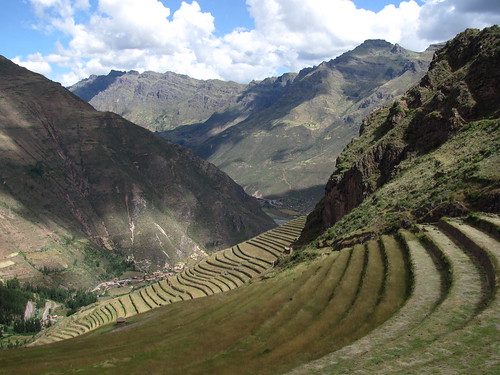

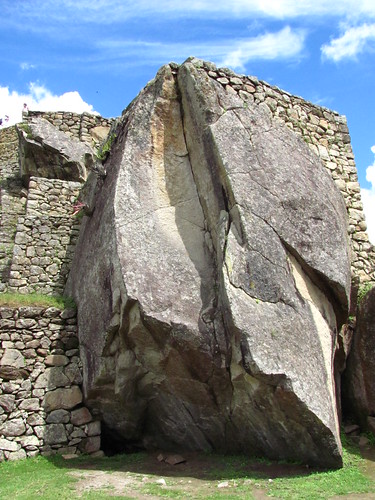

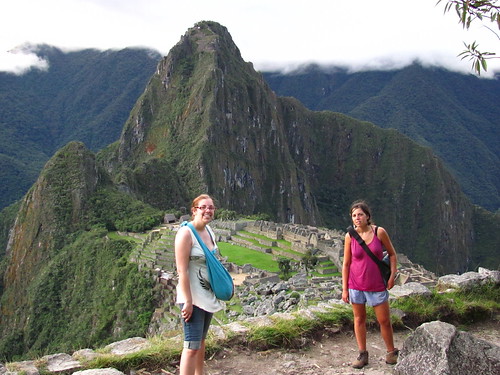


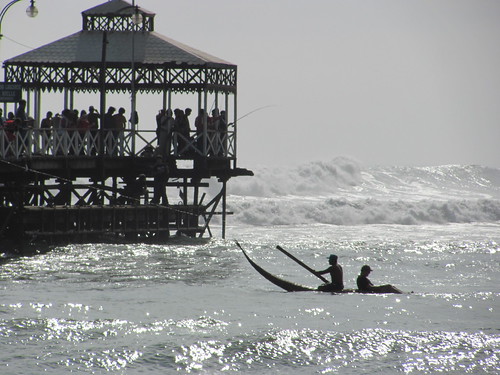


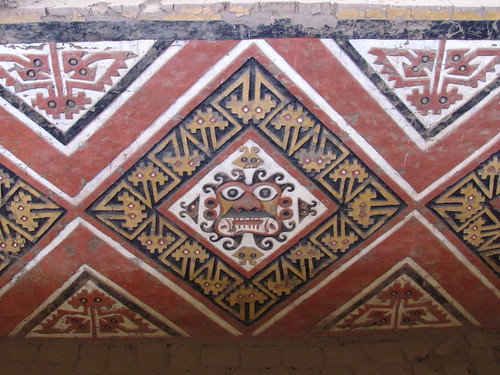
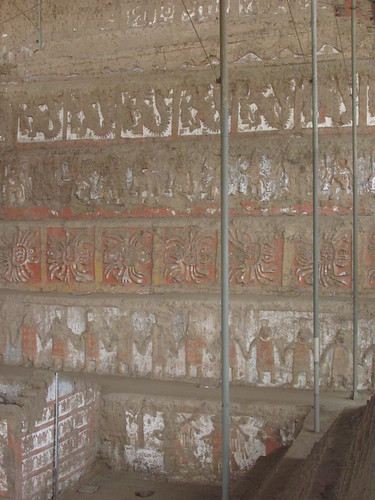

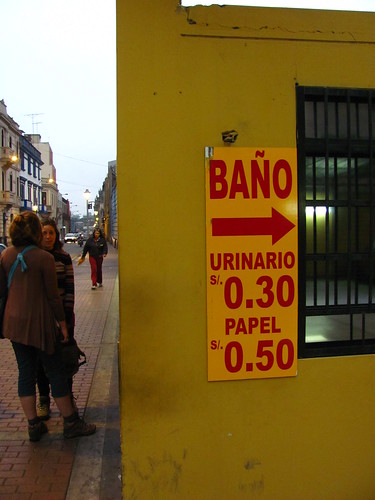
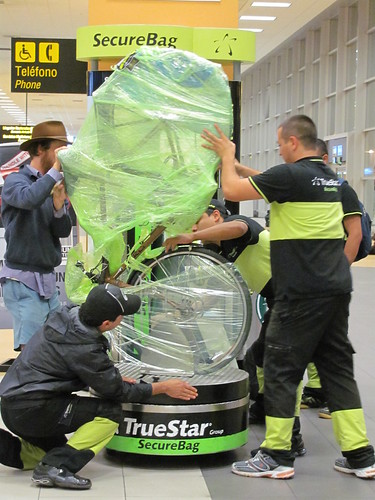
No comments:
Post a Comment